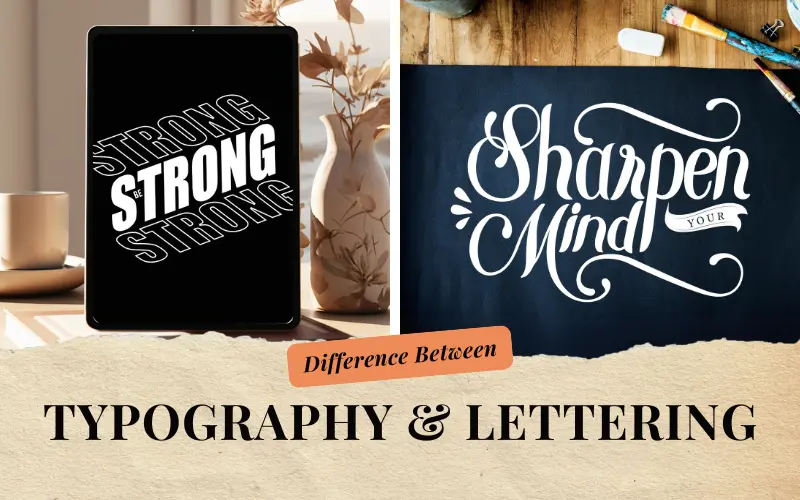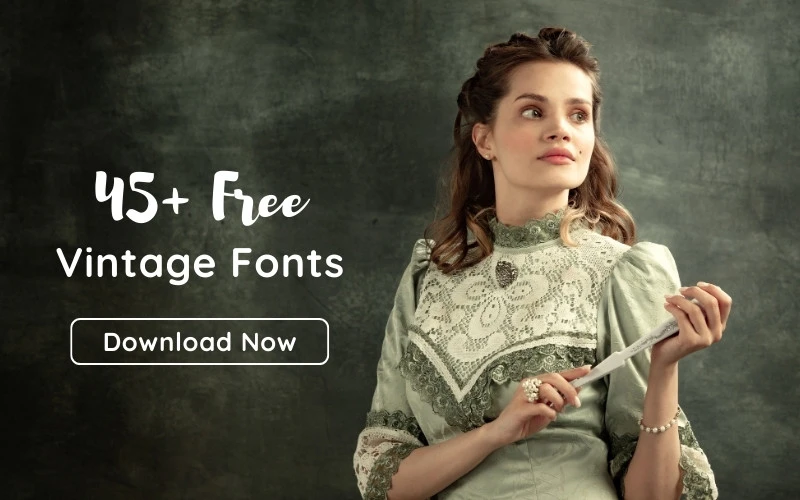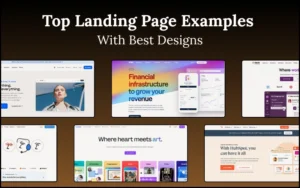Since the grunge era, the appearance of graffiti and the work of David Carson during the ‘90s, typography has been gaining momentum. More and more designers are making careers in type and custom lettering.
Still, the more typography and lettering have developed, the more misunderstanding of their meaning has occurred, and people are still confusing the concepts even nowadays. This article aims to clarify these misconceptions and explain what typography is and what is not.
Many people still say ‘cool type’ for everything that looks nice and has letters. However, they’re looking at lettering; it’s just that they don’t know the difference between typography and lettering.
Lettering is more of a craft in which shapes are designed to match each other in a specific word or phrase.
Check out this ultimate guide to the basics of typography.
Table of contents
Why Is The Difference So Confusing (And Why Is That So Important)?
Even designers confuse typography and lettering because they are created with the same tools and methods: our computers. Lettering can only be done with brushes/nibs and ink, while types are made with letterpress and printing presses.
Lettering is used only for specific purposes, meaning each design is written only once and in a determined context.
Conversely, types’ letter shapes are usually the same in every context. Finally, fonts use alternated ligatures to emulate the variation of lettering, while the type remains the same: systematized premade letters subject to reproduction.
Check out: Typographic Quotes Bundle
What Is Typography?
Image source: Ryan Feerer
Typography examines how letterforms interact with each other when on the same surface and decides how the type should be set for prints. Certain definitions describe it as the arrangement, style, and appearance of typeset, and it is a product of movable printing systems used for centuries.
Typesetting is also related to type design, and it represents a basic skill most of us should know to cope with this digitally-driven design environment.
Check out: The Mega Typography Bundle
Significance Of Typography

At the very dawn of the printing press, characters were first physically moulded and then transferred to a typesetting machine to be imprinted on paper. Nowadays, typography is digital and far more accessible to large masses. Typesetting machines are replaced by programs such as Photoshop, Illustrator, and other font editors.
Typography is the ancestor of lettering because it studies the letters applied to typefaces. For certain designers, letterpress printing is more of a hobby, and they use either typesetting or typography for many of their projects.
This being said, it is no wonder people confuse lettering with typography, but for designers, this mistake must be avoided when discussing projects with their clients.
Typography (or custom lettering) is what they’re supposed to use in logos, and the client has to know that. The right terms are essential for proper communication.
What Is Lettering?
Image source: MUTI
Lettering is more about drawing than writing. This means that even someone who can’t say or understand a single word in Japanese can design a breathtaking Japanese script. Compared to typography, lettering is more easygoing and prioritizes art over strict design rules.
The easiest way to understand lettering is to think of it as having a double personality: on the one side, it illustrates letters to create a configurable design, but on the other, it is used to create artistic compositions rather than throwing individual pieces that may or may not work together.
The letterer’s process is to ‘scratch’ his letters on paper, a Wacom tablet, or via image editing programs and add artistic elements only afterwards. However, the final product should still appear as a transcending medium.
Finally, lettering is perceived as quirky and less perfect than military-perfected typography. But according to many, that’s exactly where the charm hides.
Check out: TypeZilla 2: Super Premium Handcrafted Typography Set
Significance Of Lettering
Image source: Simon Walker
At its core, lettering is a personal and artistic approach to creating text. Unlike typography, which focuses on arranging typefaces and letters consistently and functionally for readability, lettering is all about crafting custom letters, often by hand.
Lettering brings a personal touch and creativity to text, making each letter a piece of art, whereas typography ensures that letters work harmoniously across various mediums.
Typography Vs Lettering: Differences and Similarities
Image source: Steve Wolf
Typography and lettering share the same visual concepts, such as spacing, contrast, and weight, so certain design rules often apply to both disciplines.
The terms used to describe the two differ. For instance, we call the space between two text lines in a typeset ‘leading’, mostly referring to the specific lead strip printers would add to the lines to make text look more organized. In the case of lettering, the same concept would be called line spacing.
Image source: Steve Wolf
Space is often neglected when speaking of letters, but that doesn’t weaken its importance. And the fact that it is exactly the space that designers get wrong in some horrible typography. Working with types also refers to adjusting horizontal spaces between the characters (the so-called kerning).
In typesetting, kerns are glyph parts that extend beyond the type blocks used as bases for moulding characters.
In the case of lettering, however, this should not be discussed as kerning. To be clearer, ‘A’ and ‘V’ will not be kerned. But they were brought closer to each other by tightening the space between them.
Check out: Beautiful Web Typography – Best Practices And Fonts To Use
Image source: Szende Brassai / Adline
Typography originates from lettering and calligraphy, complemented by hand-lettered decorations and inspired by traditional and sophisticated calligraphic styles.
Calligraphy is another kind of lettering, namely writing artistically, using built-up letters and drawing with multiple strokes. On the other hand, typography involves using prefabricated writing or letters already designed for another purpose. As you see, purpose is the most important difference between the two.
Image source: Simon Walker
Before typography appeared on the horizon, scribes used calligraphy to write entire books by hand. They did this amazingly and functionally, adding aesthetic value that can hardly ever be achieved with digital means.
Artists work on special paper and use distinctive pens, brushes, and inks to blend strokes together and flourish. Many other tools can divide traditional calligraphy from technology, even if the human touch is always the most valued one.
Conclusion
Typography is not lettering, and lettering is not typography. Although they are quite similar since they both involve letters, their context and use are very different. The difference mainly consists of hand drawings being full of character and personalized messages and, therefore, meant for one-time use.
Check out: Importance Of Typography In Web Design
We hope our separate explanations of lettering and typography have improved your ability to distinguish them and your skills in using them properly for your projects. Similar or diverse, lettering and typography are huge and important design sections.
Like this post? Check out more amazing web design content here.












